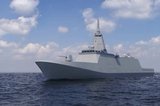Orbit to supply satcoms for naval military platforms in Asia
The Orbit OceanTRx 7MIL antenna. (Photo: Orbit Communications Systems, Ltd)
Orbit Communication Systems Ltd. has signed a US$6 million contract to supply advanced satellite communication systems for new naval military platforms in Asia. The company’s OceanTRx 7MIL systems will be delivered across the platforms between 2025–30, and will allow the fleets continuous satellite connectivity irrespective of environment or sea state (up to sea state 6).
As a modular satcoms system, the OceanTRx 7MIL can support a variety of antenna system configurations, and operate on X, Ku, Ka and C frequencies. That allows for the simultaneous operation of a variety of frequencies for global activities. The addition of a bespoke switching matrix, also from Orbit, allows multiple internal connections and the switching of up to eight antennas and eight modems, according to the requirements of individual customers.
The OceanTRx 7MIL is designed to operate on modern warships, with all the electromagnetic and signal noise that entails. It can add automatic switching of dual and multiple bands to a ship’s satcom operations, and has been ruggedized for operation in a military setting.
Related Articles
Orbit to collaborate with ViaSat for the development of new satellite terminals
Orbit CEO Daniel Eshchar added that the OceanTRx 7MIL “offered a dual-band capability that meets both military and civilian needs on a single system”.
With a diameter of 7 feet (2.2 metres), the OceanTRx 7MIL maximises the signal availability it gets from minimal real estate, and has an intuitive interface, meaning it is relatively easy to set up, operate and maintain, Orbit added. The company also said it planned to build an extensive backlog of OceanTRx 7MIL antennae to power its continuing expansion on fleets across Asia.
More from Naval Warfare
-
![NATO tests use of “undetectable, jam-proof” laser communication in maritime scenarios]()
NATO tests use of “undetectable, jam-proof” laser communication in maritime scenarios
As part of its effort to better prepare its capabilities for operations in contested and congested scenarios, NATO evaluated a Lithuanian ship-to-ship terminal designed to not be susceptible to enemy interference.
-
![US Navy advances with the Harpoon Service Life Extension Programme]()
US Navy advances with the Harpoon Service Life Extension Programme
The US Navy plans to improve Harpoon’s anti-ship and land attack capabilities by equipping the missiles with sensors and technologies required for succeeding in future battlespace.
-
![Mitsubishi eyes future with Australia’s Mogami selection]()
Mitsubishi eyes future with Australia’s Mogami selection
With Australia’s selection of the Mogami-class for Project Sea 3000, Mitsubishi is investigating local production in the next decade as potential export opportunities emerge.
-
![Hanwha wins Australian government approval to increase its stake in Austal]()
Hanwha wins Australian government approval to increase its stake in Austal
The contract would mean the two shipbuilders can collaborate strategically and enhance shipbuilding capabilities in Western Australia.






















